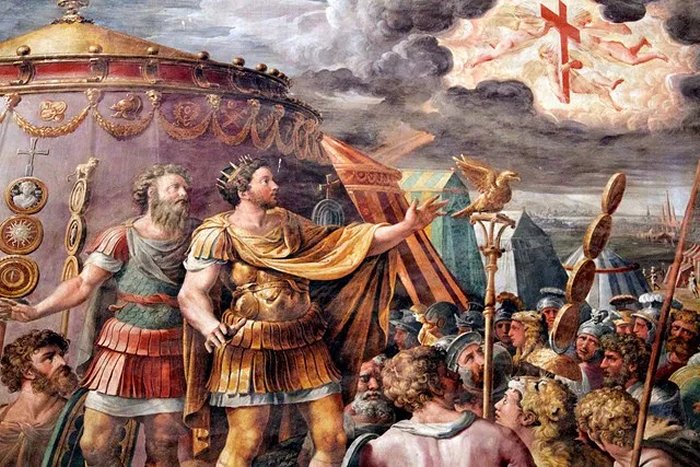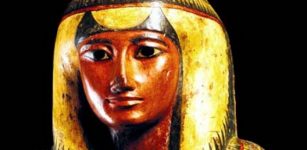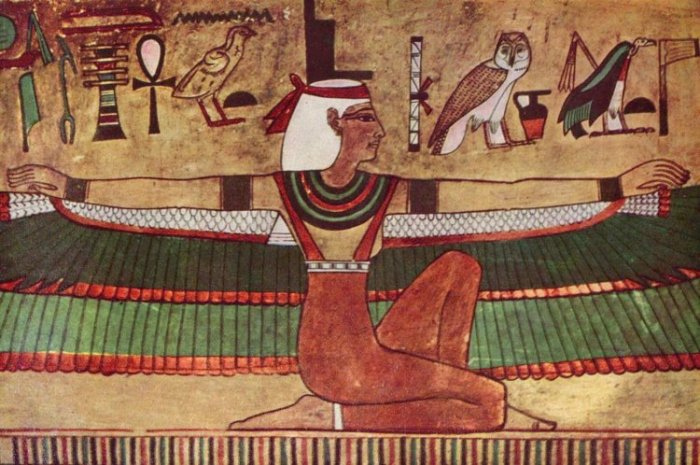Egyptian Gods’ Battle For Ancient Rome – Apis And Isis Cult Against Christianity
Ellen Lloyd - AncientPages.com - Spreading Christianity in ancient Rome and gaining new followers was not an easy task. Pagans and Emperors alike were opponents of the new faith. Christians were treated as intruders, enemies and traitors to the ancient Pagan gods.
Main rivals to Christianity were followers of the Apis and Isis cult. Apis and Isis, two ancient Egyptian gods who gained plenty of popularity among Romans. Both these cults tried to become the most dominant power of ancient Rome. However, at the end Christianity won this religious battle because Christians were best organized, united a had good allies.
Apis Cult In Ancient Rome
Apis, the sacred bull of the Egyptian capital Memphis was considered a manifestation of the god Ptah. Whenever an Apis bull died in Memphis it was embalmed, mummified and buried in a necropolis at Saqqara.
Each bull had its own huge sarcophagus, which was placed in one of these underground chambers. Ancient Egyptians recorded the animal's birth and death, and the dates were carved on a stone stelae set into the walls of the burial place. This was done in a way similar to our modern graveyards.
The bull-god was believed to be the manifestation or living image of Ptah. Credit: Land Of Pyramids
A prospective new Apis bull was required to have a white crescent on one side of its body or a white triangle on its forehead. This was a symbol representing its unique character and thus a sign the animal had been accepted by the gods. Once the Apis bull was chosen, its mother was also honored, and buried in catacombs at Saqqara set aside for the purpose. The bull was a symbol of strength and courage.
The Apis cult (3,000 B.C. - 400 A.D.) spread from Alexandria and became one of the most widespread Eastern cults in the Roman Empire. To ancient Romans, the bull was so sacred that the animal even had its own official bodyguard (a lictor) who protected it.
Isis Cult In Ancient Rome
The Isis cult (2,500 B.C. - 400 A.D.) in ancient Rome was the greatest rival to Christianity. Isis was one of the most important Egyptian goddess. Isis was an Egyptian goddess of magic, fertility and motherhood, and death, healing and rebirth. Married to the Egyptian god Osiris Isis was regarded as a perfect mother and wife. Isis was a divine symbol of motherhood and she was often depicted nursing her son Horus, just like Virgin Mary.
The Goddess Isis, wall painting, c. 1360 BCE. Credit: The Yorck Project Gesellschaft für Bildarchivierung GmbH
The cult of Isis involved initiation, baptism, and service and promised eventual salvation.
This also explains why Christianity had to struggle to overcome the Isis cult. One of the main reasons why Christians were victorious over the Isis followers was because the latter were very divided. Basically Isis followers lacked proper unity because the believers practiced their religion in different ways, depending on their locations. The Isis cult had no central organization in ancient Rome.
See also:
10 Types Of Ancient Crosses In Different Cultures Explained
5 Different Types Of Priests In Ancient Rome – Their Role And Responsibility Explained
Defixiones: Ancient Roman Curse Tablets Became Big Business
The message of Christianity was spread around the Roman Empire by St. Paul who founded Christian churches in Asia Minor and Greece. Eventually, he took his teachings to Rome itself.
 How The Strange Dream Of Roman Emperor Constantine Changed History
How The Strange Dream Of Roman Emperor Constantine Changed History
Life in ancient Rome was very difficult if you were a Christian. Christianity was banned and Christians were punished for many years.
Whoever, over time, the Christian church and faith grew more organized. In 313 AD, the Emperor Constantine issued the Edict of Milan, which accepted Christianity and persecution of Christians ended.
Written by Ellen Lloyd – AncientPages.com
Copyright © AncientPages.com & Ellen Lloyd All rights reserved. This material may not be published, broadcast, rewritten or redistributed in whole or part without the express written permission of AncientPages.com and Ellen Lloyd
About the author:
Ellen Lloyd – is the owner of AncientPages.com and an author who has spent decades researching ancient mysteries, myths, legends and sacred texts, but she is also very interested in astronomy, astrobiology and science in general
More From Ancient Pages
-
 Cocoa, Caffeinated ‘Black Drink’ Widely Used In Native American Societies
News | Sep 8, 2015
Cocoa, Caffeinated ‘Black Drink’ Widely Used In Native American Societies
News | Sep 8, 2015 -
 World’s Oldest Mercury Poisoning Revealed In Copper Age Iberia
Archaeology | Nov 16, 2021
World’s Oldest Mercury Poisoning Revealed In Copper Age Iberia
Archaeology | Nov 16, 2021 -
 3,200-Year-Old Mycenaean Statuette Sheds New Light On The Hittites
Archaeology | Jun 22, 2022
3,200-Year-Old Mycenaean Statuette Sheds New Light On The Hittites
Archaeology | Jun 22, 2022 -
 Lady Of Drunkenness And How God Ra Wanted To Teach Humans A Lesson
Egyptian Mythology | Jun 20, 2019
Lady Of Drunkenness And How God Ra Wanted To Teach Humans A Lesson
Egyptian Mythology | Jun 20, 2019 -
 Perfectly Preserved Roman Tombs Discovered Near City Of Capua Where Spartacus Trained As Gladiator
Archaeology | Jan 7, 2021
Perfectly Preserved Roman Tombs Discovered Near City Of Capua Where Spartacus Trained As Gladiator
Archaeology | Jan 7, 2021 -
 Never-Before-Seen Face Of A Tattooed Tashtyk Man Hidden Behind A Gypsum Death Mask Revealed
Archaeology | Jul 17, 2020
Never-Before-Seen Face Of A Tattooed Tashtyk Man Hidden Behind A Gypsum Death Mask Revealed
Archaeology | Jul 17, 2020 -
 Runes Were Just As Advanced As Roman Alphabet Writing – New Study
Archaeology | Mar 3, 2023
Runes Were Just As Advanced As Roman Alphabet Writing – New Study
Archaeology | Mar 3, 2023 -
 Cnut The Great – England’s Danish King And Ruler Of One Of The Largest Nordic Empires
Featured Stories | Jun 15, 2020
Cnut The Great – England’s Danish King And Ruler Of One Of The Largest Nordic Empires
Featured Stories | Jun 15, 2020 -
 Last Fragment Of Early Christian Christogram Found In Ancient City Of Parthicopolis, Bulgaria
Artifacts | Sep 9, 2015
Last Fragment Of Early Christian Christogram Found In Ancient City Of Parthicopolis, Bulgaria
Artifacts | Sep 9, 2015 -
 On This Day In History: Albert Einstein Publishes His General Theory Of Relativity – On Mar 20, 1916
News | Mar 20, 2017
On This Day In History: Albert Einstein Publishes His General Theory Of Relativity – On Mar 20, 1916
News | Mar 20, 2017 -
 Ancient Intercontinental Underground Tunnels Built By Survivors Of A Great Catastrophe And The Snake God Connection
Featured Stories | Jul 4, 2018
Ancient Intercontinental Underground Tunnels Built By Survivors Of A Great Catastrophe And The Snake God Connection
Featured Stories | Jul 4, 2018 -
 Secrets Of The Freemasons – Masonic Symbols Reveal Worship Of Ancient Mother Goddesses
Ancient Symbols | Jun 18, 2018
Secrets Of The Freemasons – Masonic Symbols Reveal Worship Of Ancient Mother Goddesses
Ancient Symbols | Jun 18, 2018 -
 A 2,500-Year-Old Planned City In Tarighat, Chhattisgarh, India
Civilizations | Oct 8, 2014
A 2,500-Year-Old Planned City In Tarighat, Chhattisgarh, India
Civilizations | Oct 8, 2014 -
 Ancient Mystery Of The Man Mound And The Giant With Horns In Wisconsin
Featured Stories | Mar 1, 2021
Ancient Mystery Of The Man Mound And The Giant With Horns In Wisconsin
Featured Stories | Mar 1, 2021 -
 New Clues About The Fascinating Ancient Roman City Falerii Novi Revealed By Scientists
Archaeology | Sep 13, 2022
New Clues About The Fascinating Ancient Roman City Falerii Novi Revealed By Scientists
Archaeology | Sep 13, 2022 -
 Unique Ancient Map Depicting The Earth As Seen From Space Restored Digitally
Archaeology | Dec 18, 2017
Unique Ancient Map Depicting The Earth As Seen From Space Restored Digitally
Archaeology | Dec 18, 2017 -
 European Mythical Creatures Encountered In The Witcher Series
Featured Stories | Feb 4, 2020
European Mythical Creatures Encountered In The Witcher Series
Featured Stories | Feb 4, 2020 -
 Sha-Amun-en-su – Tragic Fate Of Ancient Egyptian Priestly Singer’s Unopened Sarcophagus
Featured Stories | Jun 25, 2021
Sha-Amun-en-su – Tragic Fate Of Ancient Egyptian Priestly Singer’s Unopened Sarcophagus
Featured Stories | Jun 25, 2021 -
 Fossils Of Mysterious Homo Naledi Change Our Understanding Of Evolution
Archaeology | May 10, 2017
Fossils Of Mysterious Homo Naledi Change Our Understanding Of Evolution
Archaeology | May 10, 2017 -
 Legendary Grianán Of Aileach Built By God Dagda Of Tuatha De Danann Was Once The Royal Seat Of The Kingdom Of Ailech
Featured Stories | May 13, 2021
Legendary Grianán Of Aileach Built By God Dagda Of Tuatha De Danann Was Once The Royal Seat Of The Kingdom Of Ailech
Featured Stories | May 13, 2021



